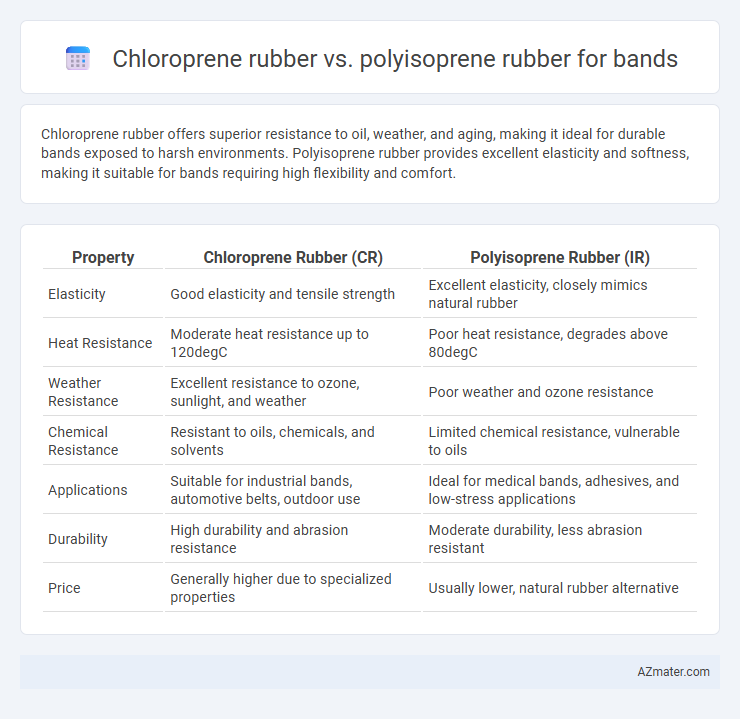Chloroprene rubber offers superior resistance to oil, weather, and aging, making it ideal for durable bands exposed to harsh environments. Polyisoprene rubber provides excellent elasticity and softness, making it suitable for bands requiring high flexibility and comfort.
Table of Comparison
| Property | Chloroprene Rubber (CR) | Polyisoprene Rubber (IR) |
|---|---|---|
| Elasticity | Good elasticity and tensile strength | Excellent elasticity, closely mimics natural rubber |
| Heat Resistance | Moderate heat resistance up to 120degC | Poor heat resistance, degrades above 80degC |
| Weather Resistance | Excellent resistance to ozone, sunlight, and weather | Poor weather and ozone resistance |
| Chemical Resistance | Resistant to oils, chemicals, and solvents | Limited chemical resistance, vulnerable to oils |
| Applications | Suitable for industrial bands, automotive belts, outdoor use | Ideal for medical bands, adhesives, and low-stress applications |
| Durability | High durability and abrasion resistance | Moderate durability, less abrasion resistant |
| Price | Generally higher due to specialized properties | Usually lower, natural rubber alternative |
Introduction to Chloroprene and Polyisoprene Rubber
Chloroprene rubber (CR) is a synthetic elastomer known for its excellent chemical stability, weather resistance, and superior tensile strength, making it ideal for bands exposed to harsh environments. Polyisoprene rubber (IR), a natural or synthetic elastomer, offers outstanding elasticity, low hysteresis, and good abrasion resistance, enhancing comfort and durability in band applications. Both materials provide unique mechanical properties that influence performance, with chloroprene emphasizing resistance and polyisoprene focusing on flexibility and softness.
Chemical Structure and Composition Differences
Chloroprene rubber (CR) consists of polychloroprene units with chlorine atoms attached to the polymer backbone, enhancing its chemical resistance and flame retardancy, whereas polyisoprene rubber (IR) is composed of repeating isoprene units without halogen atoms, resulting in higher elasticity and tensile strength. The presence of chlorine in chloroprene rubber's chemical structure increases its stability against oils, ozone, and weathering, making it suitable for durable bands requiring chemical resistance. In contrast, polyisoprene rubber's unsaturated hydrocarbon chain provides superior flexibility and resilience, ideal for applications prioritizing elasticity over chemical resistance.
Physical Properties Comparison
Chloroprene rubber exhibits superior chemical resistance, higher tensile strength, and greater weathering durability compared to polyisoprene rubber, making it ideal for bands exposed to outdoor or harsh environments. Polyisoprene rubber offers excellent elasticity and resilience but has lower resistance to heat and oils, limiting its use in applications requiring prolonged exposure to such conditions. The compression set of chloroprene rubber is generally better, ensuring longer-lasting shape retention in dynamic band applications.
Mechanical Strength and Durability
Chloroprene rubber offers superior mechanical strength with excellent tensile and tear resistance, making it ideal for bands requiring robust durability under tension and repeated stress. Polyisoprene rubber provides good elasticity and resilience but generally exhibits lower abrasion resistance and mechanical strength compared to chloroprene. For applications demanding long-term durability and resistance to environmental factors like ozone and oils, chloroprene outperforms polyisoprene, ensuring prolonged band performance.
Elasticity and Flexibility in Band Applications
Chloroprene rubber offers superior elasticity and excellent resistance to environmental factors, making it ideal for bands requiring durability and consistent performance under stress. Polyisoprene rubber closely mimics natural rubber's high flexibility and stretchability, providing exceptional comfort and adaptability in applications needing soft, elastic bands. Choosing between chloroprene and polyisoprene depends on the balance between environmental resilience and natural flexibility demanded by the specific band use.
Resistance to Environmental Factors
Chloroprene rubber exhibits superior resistance to ozone, weathering, and heat compared to polyisoprene rubber, making it ideal for bands exposed to outdoor or harsh environmental conditions. Polyisoprene rubber offers excellent tensile strength and elasticity but deteriorates faster under UV radiation and ozone exposure. For applications requiring long-term durability against environmental factors, chloroprene bands provide enhanced protection and longevity.
Cost and Availability
Chloroprene rubber is more cost-effective and widely available compared to polyisoprene rubber, making it suitable for bands requiring budget-friendly material without compromising durability. Polyisoprene rubber, while offering superior elasticity and resilience, tends to be more expensive and less readily accessible due to limited production and higher processing costs. Manufacturers often choose chloroprene for mass-produced bands to optimize cost-efficiency and supply stability.
Safety and Allergenicity
Chloroprene rubber, commonly known as neoprene, offers superior resistance to chemicals and ozone while typically exhibiting lower allergenic potential compared to natural polyisoprene rubber, making it safer for prolonged skin contact in band applications. Polyisoprene rubber, derived from natural latex, presents a higher risk of triggering allergic reactions due to latex proteins, which is critical for users with latex sensitivity. In environments demanding hypoallergenic materials, chloroprene rubber provides a safer alternative, reducing the incidence of contact dermatitis and allergic responses.
Typical Applications of Each Rubber for Bands
Chloroprene rubber (CR) is widely used in industrial and automotive bands due to its excellent resistance to oil, heat, and weathering, making it ideal for conveyor belts and drive belts in harsh environments. Polyisoprene rubber (IR), with its superior elasticity and tensile strength, is primarily used in medical and surgical bands where natural latex alternatives are required for skin sensitivity. Both rubbers serve different applications: CR excels in durability under chemical exposure, while IR offers outstanding flexibility and comfort in wearable bands.
Conclusion: Choosing the Right Rubber for Bands
Chloroprene rubber offers superior resistance to oils, weathering, and ozone, making it ideal for durable bands exposed to harsh environments. Polyisoprene rubber provides excellent elasticity and a natural rubber-like feel, suitable for applications requiring flexibility and comfort. Selecting the right rubber depends on the specific durability and elasticity requirements of the band's intended use.

Infographic: Chloroprene rubber vs Polyisoprene rubber for Band
 azmater.com
azmater.com